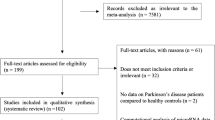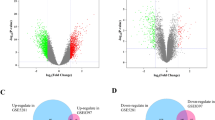Abstract
Introduction
Olfactory dysfunction (OD), one of the most common non-motor symptoms in Parkinson’s disease (PD), is a cardinal prodromal symptom that can appear years before the onset of motor symptoms. Ongoing studies have demonstrated that microRNAs (miRNAs) are suitable biomarkers for PD, while there is a lack of robust miRNAs that can serve as markers for OD in PD.
Methods
The concordantly differentially expressed miRNAs (DE miRNAs) in the damaged olfactory system were first identified in 2 OD-related Gene Expression Omnibus (GEO) datasets. Then, they were verified in another PD-related GEO dataset and only one miRNA (miR-20a) was found to be significantly altered. Serum levels of miR-20a were further measured by qPCR in 79 PD patients with OD (PD-OD), 52 PD patients without OD (PD-NOD), and 52 healthy controls (HC). Objective measure of OD was defined by 16-item Sniffin’ Sticks odor identification test. All the participants underwent a demographic and comprehensive PD-related clinical assessment.
Results
Our results proved that miR-20a was significantly downregulated in PD-OD compared with PD-NOD and the area under curve (AUC) for OD detection by miR-20a was 0.803 (95% confidence interval, 0.724–0.883). In addition, PD-OD had higher scores of Movement Disorder Society-Unified Parkinson’s Disease Rating Scale (UPDRS) II, Hoehn and Yahr stage (H–Y), Non-Motor Symptoms Scale (NMSS) 3, NMSS 5, NMSS 9, Hamilton Rating Scale for Depression (HAMD), Hamilton Anxiety Scale (HAMA), Activity of Daily Living (ADL), and lower scores of Mini-Mental State Examination (MMSE) and 39-item PD Quality of Life Questionnaire (PDQ-39) than PD-NOD. Binary regression model further presented that lower expressions of miR-20a and poorer cognitive function acted as promoting factors in the development of OD.
Conclusion
Our results suggest that miR-20a could be a novel biomarker for OD in PD and PD-OD patients tend to have higher disease stage, poorer motor aspects of experiences of daily living, worse cognitive scores, and inferior quality of life, and were more likely to have mental disorders. Cognitive function, in particular, is strongly associated with OD in PD patients.



Similar content being viewed by others
Data availability
Data available on request from the authors.
References
Fearnley JM, Lees AJ (1991) Ageing and Parkinson’s disease: substantia nigra regional selectivity. Brain 114:2283–2301
Bloem BR, Okun MS, Klein C (2021) Parkinson’s disease. Lancet 397(10291):2284–2303
Schapira AHV, Chaudhuri KR, Jenner P (2017) Non-motor features of Parkinson disease. Nat Rev Neurosci 18(7):435–450
Boesveldt S, Verbaan D, Knol DL et al (2008) A comparative study of odor identification and odor discrimination deficits in Parkinson’s disease. Mov Disord 23(14):1984–1990
Postuma RB, Berg D, Stern M et al (2015) MDS clinical diagnostic criteria for Parkinson’s disease. Mov Disord 30(12):1591–1601
Dan X, Wechter N, Gray S et al (2021) Olfactory dysfunction in aging and neurodegenerative diseases. Ageing Res Rev 70:101416
Kim JE, Oh E, Park J et al (2018) Serum 25-hydroxyvitamin D3 level may be associated with olfactory dysfunction in de novo Parkinson’s disease. J Clin Neurosci 57:131–135
Campolo J, De Maria R, Cozzi L et al (2016) Antioxidant and inflammatory biomarkers for the identification of prodromal Parkinson’s disease. J Neurol Sci 370:167–172
Ibarretxe-Bilbao N, Junque C, Marti MJ et al (2010) Olfactory impairment in Parkinson’s disease and white matter abnormalities in central olfactory areas: a voxel-based diffusion tensor imaging study. Mov Disord 25(12):1888–1894
Grillari J, Mäkitie RE, Kocijan R et al (2021) Circulating miRNAs in bone health and disease. Bone 145:115787
Wang H (2021) MicroRNAs, Parkinson's disease, and diabetes mellitus. Int J Mol Sci 22(6):2953
Goh SY, Chao YX, Dheen ST et al (2019) Role of MicroRNAs in Parkinson’s disease. Int J Mol Sci 20(22):5649
Cressatti M, Juwara L, Galindez JM et al (2020) Salivary microR-153 and microR-223 levels as potential diagnostic biomarkers of idiopathic Parkinson’s disease. Mov Disord 35(3):468–477
Li L, Ren J, Pan C et al (2021) Serum miR-214 serves as a biomarker for prodromal Parkinson’s disease. Front Aging Neurosci 13:700959
Chen Y, Gao C, Sun Q et al (2017) MicroRNA-4639 is a regulator of DJ-1 expression and a potential early diagnostic marker for Parkinson’s disease. Front Aging Neurosci 9:232
Zhang HQ, Wang JY, Li ZF et al (2021) DNA methyltransferase 1 is dysregulated in Parkinson’s disease via mediation of miR-17. Mol Neurobiol 58(6):2620–2633
Behbahanipour M, Peymani M, Salari M et al (2019) Expression profiling of blood microRNAs 885, 361, and 17 in the patients with the Parkinson’s disease: integrating interaction data to uncover the possible triggering age-related mechanisms. Sci Rep 9(1):13759
Mogilyansky E, Rigoutsos I (2013) The miR-17/92 cluster: a comprehensive update on its genomics, genetics, functions and increasingly important and numerous roles in health and disease. Cell Death Differ 20(12):1603–1614
Jiang S, Fang X, Liu M et al (2019) MiR-20b down-regulates intestinal ferroportin expression in vitro and in vivo. Cells 8(10):1135
Wang Q, Wang Y, Zhou F et al (2021) MiR-20a-5p regulates MPP+-induced oxidative stress and neuroinflammation in HT22 cells by targeting IRF9/NF-κB axis. Evid Based Complement Alternat Med 2021:6621206
Chen W, Chen S, Kang WY et al (2012) Application of odor identification test in Parkinson’s disease in China: a matched case-control study. J Neurol Sci 316(1–2):47–50
Chen Y, Xu Q, Wu L et al (2023) REM sleep behavior disorder correlates with constipation in de novo Chinese Parkinson’s disease patients. Neurol Sci 44(1):191–197
Liu R, Umbach DM, Peddada SD et al (2015) Potential sex differences in nonmotor symptoms in early drug-naive Parkinson disease. Neurology 84(21):2107–2115
Haehner A, Boesveldt S, Berendse HW et al (2009) Prevalence of smell loss in Parkinson’s disease–a multicenter study. Parkinsonism Relat Disord 15(7):490–494
Picillo M, Amboni M, Erro R et al (2013) Gender differences in non-motor symptoms in early, drug naïve Parkinson’s disease. J Neurol 260(11):2849–2855
Masala C, Solla P, Liscia A et al (2018) Correlation among olfactory function, motors’ symptoms, cognitive impairment, apathy, and fatigue in patients with Parkinson’s disease. J Neurol 265(8):1764–1771
Lee DH, Oh JS, Ham JH et al (2015) Is normosmic Parkinson disease a unique clinical phenotype? Neurology 85(15):1270–1275
Berendse HW, Roos DS, Raijmakers P et al (2011) Motor and non-motor correlates of olfactory dysfunction in Parkinson’s disease. J Neurol Sci 310(1–2):21–24
Dhawan V, Healy DG, Pal S et al (2006) Sleep-related problems of Parkinson’s disease. Age Ageing 35(3):220–228
Herting B, Schulze S, Reichmann H et al (2008) A longitudinal study of olfactory function in patients with idiopathic Parkinson’s disease. J Neurol 255(3):367–370
Ramjit AL, Sedig L, Leibner J et al (2010) The relationship between anosmia, constipation, and orthostasis and Parkinson’s disease duration: results of a pilot study. Int J Neurosci 120(1):67–70
Doty RL (2012) Olfaction in Parkinson’s disease and related disorders. Neurobiol Dis 46(3):527–552
Blonder LX, Slevin JT (2011) Emotional dysfunction in Parkinson’s disease. Behav Neurol 24(3):201–217
Soudry Y, Lemogne C, Malinvaud D et al (2011) Olfactory system and emotion: common substrates. Eur Ann Otorhinolaryngol Head Neck Dis 128(1):18–23
Péron J, Dondaine T, Le Jeune F et al (2012) Emotional processing in Parkinson’s disease: a systematic review. Mov Disord 27(2):186–199
Seppi K, Ray Chaudhuri K, Coelho M et al (2019) Update on treatments for nonmotor symptoms of Parkinson’s disease–an evidence-based medicine review. Mov Disord 34(2):180–198
Fullard ME, Tran B, Xie SX et al (2016) Olfactory impairment predicts cognitive decline in early Parkinson’s disease. Parkinsonism Relat Disord 25:45–51
Takeda A, Baba T, Kikuchi A et al (2014) Olfactory dysfunction and dementia in Parkinson’s disease. J Parkinsons Dis 4(2):181–187
Domellöf ME, Lundin KF, Edström M et al (2017) Olfactory dysfunction and dementia in newly diagnosed patients with Parkinson’s disease. Parkinsonism Relat Disord 38:41–47
Park JW, Kwon DY, Choi JH et al (2018) Olfactory dysfunctions in drug-naïve Parkinson’s disease with mild cognitive impairment. Parkinsonism Relat Disord 46:69–73
Bohnen NI, Albin RL (2011) The cholinergic system and Parkinson disease. Behav Brain Res 221(2):564–573
Bohnen NI, Kaufer DI, Hendrickson R et al (2006) Cognitive correlates of cortical cholinergic denervation in Parkinson’s disease and parkinsonian dementia. J Neurol 253(2):242–247
Williams-Gray CH, Evans JR, Goris A et al (2009) The distinct cognitive syndromes of Parkinson’s disease: 5 year follow-up of the CamPaIGN cohort. Brain 132(Pt 11):2958–2969
Kotagal V, Muller MT, Koeppe RA et al (2009) Parkinson and Alzheimer-selective hyposmia measures have different neurochemical substrates in patients with Parkinson’s disease. Neurology 72(suppl 3):A146
Aarsland D, Batzu L, Halliday GM et al (2021) Parkinson disease-associated cognitive impairment. Nat Rev Dis Primers 7(1):47
Kawasaki I, Baba T, Takeda A et al (2016) Loss of awareness of hyposmia is associated with mild cognitive impairment in Parkinson’s disease. Parkinsonism Relat Disord 22:74–79
Croy I, Nordin S, Hummel T (2014) Olfactory disorders and quality of life–an updated review. Chem Senses 39(3):185–194
Kang P, Kloke J, Jain S (2012) Olfactory dysfunction and parasympathetic dysautonomia in Parkinson’s disease. Clin Auton Res 22(4):161–166
Hurt CS, Alkufri F, Brown RG et al (2014) Motor phenotypes, medication and mood: further associations with impulsive behaviours in Parkinson’s disease. J Parkinsons Dis 4(2):245–254
Opara JA, Brola W, Leonardi M et al (2012) Quality of life in Parkinson’s disease. J Med Life 5(4):375–381
Acknowledgements
We thank all participants who contributed to this study. We express our sincere appreciation to the reviewers for their constructive comments.
Funding
This study was supported by the National Natural Science Foundation of China (Grant No. 81771258).
Author information
Authors and Affiliations
Corresponding authors
Ethics declarations
Conflict of interest
The authors declare that they have no conflicts of interest.
Ethical approval
The studies involving human participants were reviewed and approved by the ethics committee of the Shanghai East hospital affiliated with Tongji University. The patients/participants provided their written informed consent to participate in this study.
Additional information
Publisher's Note
Springer Nature remains neutral with regard to jurisdictional claims in published maps and institutional affiliations.
Rights and permissions
Springer Nature or its licensor (e.g. a society or other partner) holds exclusive rights to this article under a publishing agreement with the author(s) or other rightsholder(s); author self-archiving of the accepted manuscript version of this article is solely governed by the terms of such publishing agreement and applicable law.
About this article
Cite this article
Liu, H., Zhao, H., Bao, Y. et al. Identifying the potential role of serum miR-20a as a biomarker for olfactory dysfunction in patients with Parkinson’s disease. Eur Arch Otorhinolaryngol 280, 4509–4517 (2023). https://doi.org/10.1007/s00405-023-08034-5
Received:
Accepted:
Published:
Issue Date:
DOI: https://doi.org/10.1007/s00405-023-08034-5




